

| Nottinghamshire Hawk-moths |
| ............... |
| The Hawk-moths (Sphingidae)
represent our some of our largest moths. By day, several
species rest on tree trunks, fences and walls, where they
are conspicuous because of their size and are often
people's first introduction to moths. They are all extremely well-marked moths and in terms of colouration, the Elephant Hawk-moth is possibly the most striking of all our Hawk-moths and is certainly a big favourite at public moth trapping events.Their larvae are probably encountered more than the moths themselves, often found wandering along pavements in search of an underground pupation site. Over-wintering by all UK Hawk-moths is in the pupal stage. The adults generally emerge from April to June, with only the Poplar Hawk-moth having a regular second brood later in the Summer. |
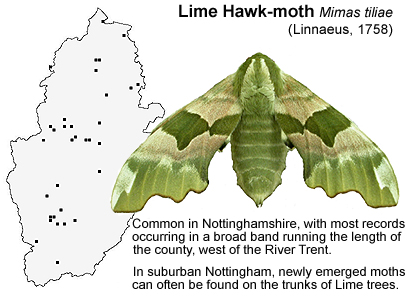 |
|
| ............... | ||
| Sphingidae (Hawk-moths) recorded in Nottinghamshire |
| ............... |
| 69.001 ... 1979 ... Mimas tiliae Lime Hawk-moth (Linnaeus, 1758) |
| 69.002 ... 1980 ... Smerinthus ocellata Eyed Hawk-moth (Linnaeus, 1758) |
| 69.003 ... 1981 ... Laothoe populi Poplar Hawk-moth (Linnaeus, 1758) |
| 69.004 ... 1972 ... Agrius convolvuli Convolvulus Hawk-moth (Linnaeus, 1758) |
| 69.005 ... 1973 ... Acherontia atropos Death's-head Hawk-moth (Linnaeus, 1758) |
| 69.006 ... 1976 ... Sphinx ligustri Privet Hawk-moth (Linnaeus, 1758) |
| 69.007 ... 1978 ... Sphinx pinastri Pine Hawk-moth (Linnaeus, 1758) |
| 69.008 ... 1982 ... Hemaris tityus Narrow-bordered Bee Hawk-moth (Linnaeus, 1758) |
| 69.009 ... 1983 ... Hemaris fuciformis Broad-bordered Bee Hawk-moth (Linnaeus, 1758) |
| 69.010 ... 1984 ... Macroglossum stellatarum Hummingbird Hawk-moth (Linnaeus, 1758) |
| 69.011 ... 1985 ... Daphnis nerii Oleander Hawk-moth (Linnaeus, 1758) |
| 69.014 ... 1987 ... Hyles gallii Bedstraw Hawk-moth (Rottemburg, 1775) |
| 69.016 ... 1991 ... Deilephila elpenor Elephant Hawk-moth (Linnaeus, 1758) |
| 69.017 ... 1992 ... Deilephila porcellus Small Elephant Hawk-moth (Linnaeus, 1758) |
| 69.018 ... 1993 ... Hippotion celerio Silver-striped Hawk-moth (Linnaeus, 1758) |
| Migrant Hawk-moths recorded in
Nottinghamshire Several Hawk-moths are migrants to the UK and these occasionally filter inland. The Hummingbird Hawk-moth Macroglossum stellatarum is the most regularly reported of these in Nottinghamshire, but several other rarer (and sometimes considerably larger) Hawk-moths reach the UK most years. Convolvulus, Death's-head, Oleander, Silver-striped and Bedstraw Hawk-moths have all turned up at some time in Nottinghamshire. The Hummingbird Hawk-moth can occur in good numbers during favourable years. We have recorded it almost annually from our own garden, but there were notable influxes in 2011, 2014 and 2015 when they were recorded county-wide nectaring on garden flowers such as Valerian. We recorded over 30 Hummingbird Hawk-moths at Valerian in our own terraced garden at Market Warsop in 2011 and had six different moths on 24/09/11 alone, identifiable by a combination of size, markings and wear. |
| Convolvulus Hawk-moth Agrius convolvuli | Death's-head Hawk-moth Acherontia atropos | |
| (Linnaeus, 1758) | . | (Linnaeus, 1758) |
| ..... | ||
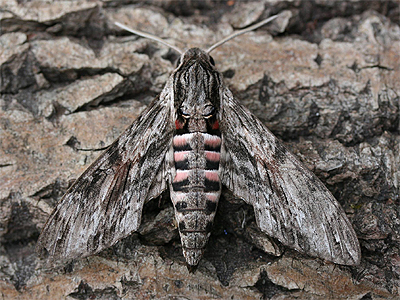 |
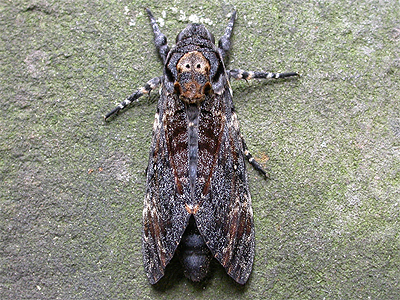 |
|
| Hummingbird Hawk-moth Macroglossum stellatarum | Oleander Hawk-moth Daphnis nerii | |
| (Linnaeus, 1758) | . | (Linnaeus, 1758) |
| ..... | ||
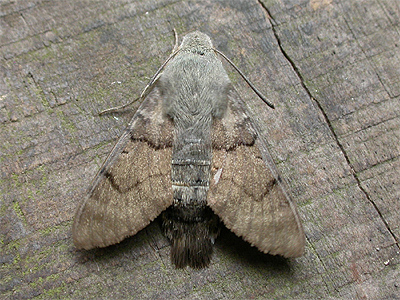 |
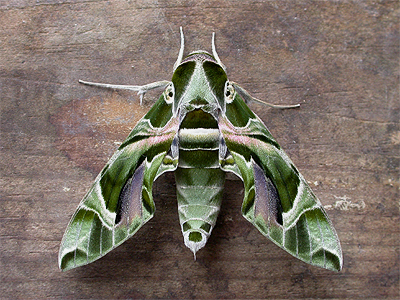 |
|
| Bedstraw Hawk-moth Hyles gallii |
The Convolvulus Hawk-moth
Agrius convolvuli is an extremely large migrant
Hawk-moth and rare in Nottinghamshire. It is certainly
not annual and the last records we are aware of, were
from Kirkby-in-Ashfield, South Leverton, Kimberley,
Flintham and Edwinstowe in 2003, Newark in 2004, East
Leake in 2005, Stanton-on-the-Wolds and Edingley and in
2006 and Radcliffe-on-Trent in 2008 (per Sheila Wright). The most recent record came from West
Bridgford in 2015. An extremely rare migrant to Nottinghamshire, the Death's-head Hawk-moth Acherontia atropos was certainly more frequent a century or more ago. J.W. Carr in his book 'The Invertebrate Fauna of Nottinghamshire. Nottingham: J.& H. Bell Ltd. (1916)' lists numerous records, many of either larvae or pupae found during potato harvesting. As harvesting is now done by mechanical methods, there are fewer reports of this spectacular moth and the most recent records of a genuine migrant Death's-head Hawk-moth in Nottinghamshire, is of a female recorded by G. Shaw at East Retford on 04/07/66 (NGBRC) and most recently at Lound GP on 10/09/95 when recorded by Gary and Paul Hobson, although the record was never submitted to the county recorder for verification at the time. A very rare migrant to the UK and an even rarer moth inland, the spectacular Oleander Hawk-moth has surprisingly occurred once in Nottinghamshire, with one recorded from Clumber Park in 1985 (Jones, M.). |
|
| (Rottemburg, 1775) | ||
| .................................................................................................................................................... | ||
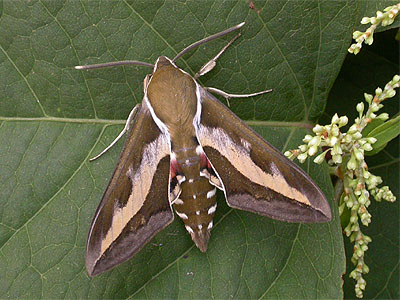 |
||
| Bedstraw
Hawk-moth Hyles gallii is considerably rarer
than the Convolvulus Hawk-moth, but we have been
fortunate enough to record this moth on two occasions in
Nottinghamshire, including a full grown larva found on
Rosebay Willowherb (Epilobium sp) at Clipstone
Old Quarter on 2004, an adult netted at dusk nectaring on
Valerian at Eakring in 2006. The last few Nottinghamshire
records of Bedstraw Hawk-moth include single adults at
Collingham in 2003, Rainworth in 2006 and 2007, Keyworth
in 2008 and a larva at Clipstone Forest in 2009 (per Sheila Wright). The current county status of Nottinghamshire's resident species Of our eight resident Hawk-moths, two particular species have done extremely well in recent decades and have gradually increased their county range from the south-east. The Privet Hawk-moth is Nottinghamshire's largest species and after a period of scarcity several decades ago, has now become increasingly common across the county, after a number of years spreading up from the south-east. Privet growing in roadside hedgerows is certainly worth checking for the conspicuous larva in August and September. |
||
| Lime Hawk-moth Mimas tiliae | Eyed Hawk-moth Smerinthus ocellata | |
| (Linnaeus, 1758) | . | (Linnaeus, 1758) |
| ..... | ||
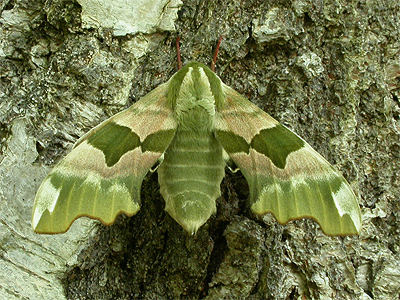 |
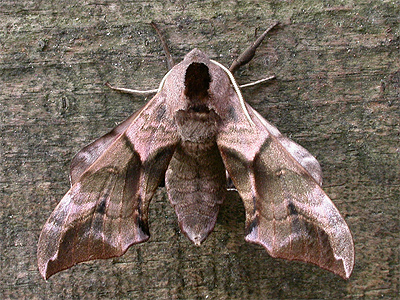 |
|
|
Common throughout Nottinghamshire, the attractively coloured Lime Hawk-moth can be found in urban areas wherever there are Lime trees. Adults can be found freshly emerged on the trunks of street trees in the Spring. The larvae will eat the leaves of other trees including Cherry and Elm, but we have found a a freshly emerged moth deep within Sherwood Forest CP (with no known foodplant nearby) and a pupa underneath the loose bark of a fallen Sweet Chestnut branch. The Poplar Hawk-moth is equally as common and should be expected wherever Poplars or Sallows grow. The larvae are common on most of the former pit tops we visit and a second generation is produced most years. The Eyed Hawk-moth is another widespread Hawk-moth and seems to be encountered less often at light, than the previous two species. In fact, we have yet to attract an Eyed Hawk-moth to MV light, but we have found the larvae on Sallow at Warsop Main Pit Top, Warsop Wood, Wellow Park, Vexation Lane near Edwinstowe and have records of larvae from Budby South Forest and on Apple at Sherwood Heath SSSI in the early 1990's.The Pine Hawk-moth has probably spread at a greater rate than the larger Privet Hawk-moth, but is still a large moth itself. It is now widespread and well established in forested areas, after first appearing in Nottinghamshire back in the 1980's. It is trapped regularly in and around the Sherwood Forest area and has benefitted enormously from the availability of commercial forestry plantations. But with the gradual reduction in forestry, this moth may begin to show a decline over the next few decades. The Broad-bordered Bee Hawk-moth has never been common in Nottinghamshire and it remains absent from several woodland sites which do seem suitable. For many years and following a number of records, Clumber Park remained the only site where breeding was known to occur, but singles have occasionally been reported from elsewhere. The moth is certainly present in the Rufford/Centre Parcs area and has recently (2021) been found and has bred has for the first time in the Sherwood Forest area, with both adults and eggs found in 2021. Other recent county records have come from Centre Parcs in 2018 (Hill, M.), Barnby-in-the-Willows (Beacock, O.) and an unsubmitted record from Thoresby Park in May 2020 (Kiemel Green, I.). In 2021 adults were seen at Clipstone Old Quarter and numerous eggs and young larvae were found on Honeysuckle at nearby Blackpool Plantation, both representing new sites for the moth in Nottinghamshire. Eggs and larvae were then found on Sherwood Heath and the question of captive releases was raised. The same question could also cast an element of doubt over Nottinghamshire's first Narrow-bordered Bee Hawk-moth (a moth declining nationally) found and photographed egg-laying at Ratcher Hill in Mansfield (Keywood, B.) in May 2021. |
Poplar Hawk-moth Laothoe populi | |
| . | (Linnaeus, 1758) | |
| ................................................................................................................................................... | ||
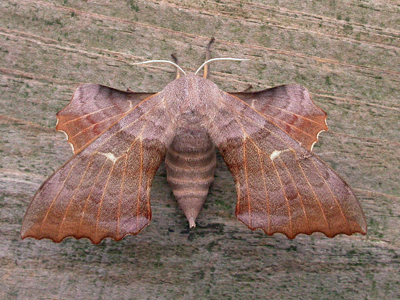 |
||
| Privet Hawk-moth Sphinx ligustri | ||
| (Linnaeus, 1758) | ||
| ..... | ||
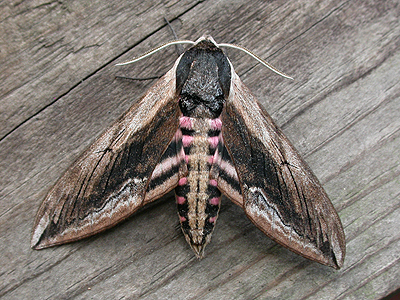 |
||
|
While both the Privet and Pine Hawk-moth are currently doing well, the Broad-bordered Bee Hawk-moth (Hemaris fuciformis) remains extremely rare in the county and in recent years has always been restricted to Clumber Park. There are plenty of other suitable localities for this moth in the Dukeries area and it came as no surprise when one was recorded nectaring at Campion flowers at Sherwood Pines Centre Parcs (Hill, M.) near Ollerton in May 2018. More records are sure to follow. |
| Pine Hawk-moth Hyloicus pinastri | Broad-bordered Bee Hawk-moth Hemaris fuciformis | |
| (Linnaeus, 1758) | . | (Linnaeus, 1758) |
| ..... | ||
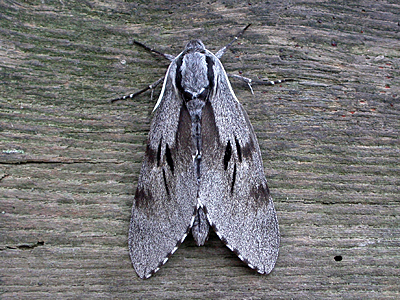 |
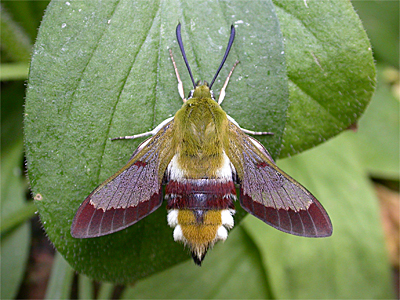 |
|
| Elephant Hawk-moth Deilephila elpenor | Small Elephant Hawk-moth Deilephila porcellus | |
| (Linnaeus, 1758) | . | (Linnaeus, 1758) |
| ..... | ||
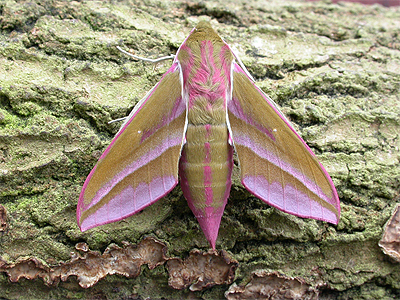 |
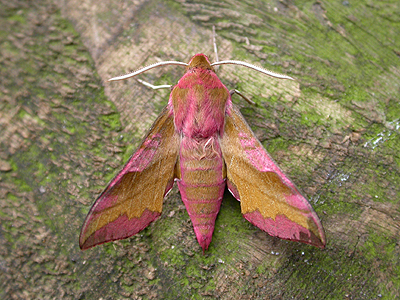 |
|
| Silver-striped Hawk-moth Hippotion celerio | ||
| (Linnaeus, 1758) | ||
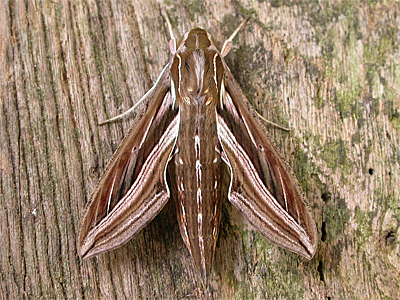 |
||
Both of our Elephant Hawk-moths are strikingly coloured moths, yet their ranges are very dfferent. Found all over Nottinghamshire, the Elephant Hawk-moth can be expected wherever Rosebay Willowherb grows, so is often found on brownfield sites within urban areas. In gardens, the larvae will eat Fuschia. The Small Elephant Hawk-moth is restricted to areas of heathland and golf courses where Bedstraw grows and even where this moth does occur, it does not seem to be at all common. We have trapped this moth on a handful of occasions at heathland sites in Sherwood Forest and we do have a surprising record for Eakring Flash. Hawk-moth larvaeHawk-moth larvae are very large when full grown and like the adult moths themselves, are frequently found by members of the public. Pre-pupating larvae of the Lime Hawk-moth and Elephant Hawk-moth, are probably the most likely to be encountered accidentally, but their habit of stripping all the leaves of single stems of their foodplant, makes most Hawk-moth larvae easy targets to search for. |
||||||
| ..... | ||||||
| Pine Hawk-moth (green form) | Pine Hawk-moth (brown form) | Privet Hawk-moth | Eyed Hawk-moth | |||
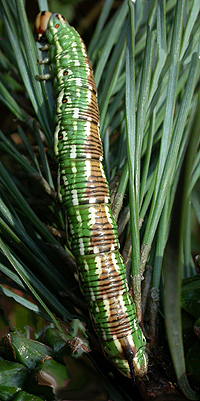 |
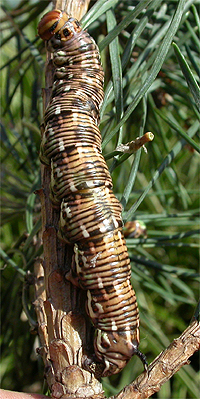 |
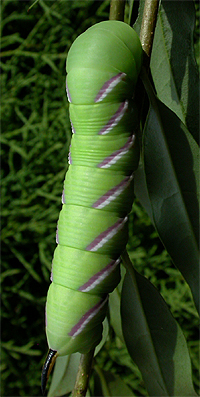 |
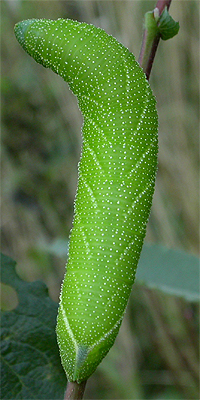 |
|||
| ..... | ||||||
| Lime Hawk-moth | ... | Elephant Hawk-moth | ... | Bedstraw Hawk-moth | ... | Oleander Hawk-moth |
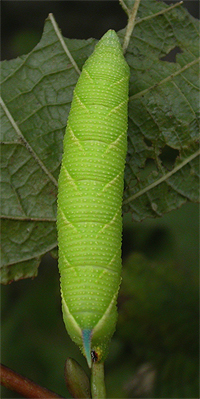 |
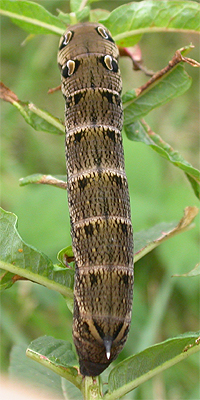 |
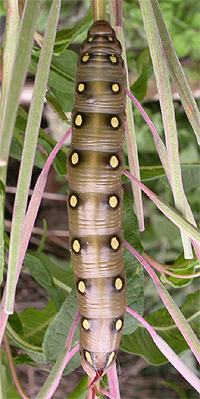 |
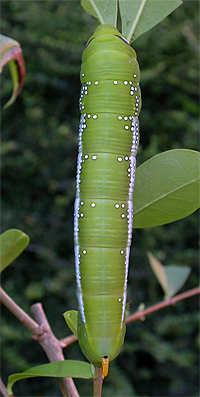 |
|||
| ..... | ||||||
| All have a
horn at the rear end (which is not poisonous), although
the horn is severely reduced in larvae of the Elephant
Hawk-moth and the Small Elephant Hawk-moth. The Elephant
Hawk-moth and Pine Hawk-moth both have larvae with green
and brown colour forms, though full grown green Elephant
Hawk-moth larvae are uncommon, even when numbers are
reared in captivity. When disturbed, most Hawk-moth larvae will adopt a Sphinx-like posture, by rearing up at the front. It is through this defensive posture that Hawk-moths derive their American common name of Sphinx moths, but the family name of Sphingidae is also derived from the name Sphinx. |
||||||
| Moths |
| Insect identification |
| Homepage |